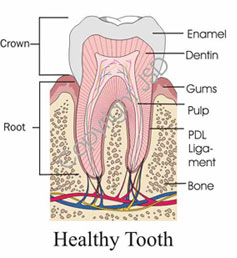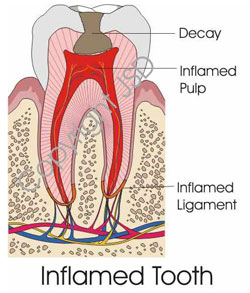What is an Endodontist?
Endodontists are dentists who specialize in saving teeth through different procedures which involve the pulp (nerve) and root of teeth. Endodontist comes from the Greek “endo” meaning inside and the word “odont” meaning tooth. All dentists are trained to treat and diagnose diseases of the pulp (nerve), however, some teeth can be especially difficult to diagnose and treat. Reason why some patients are referred to the endodontist.
An endodontist, as defined by the American Board of Endodontists, is a dental specialist in the treatment of diseases and injuries to the dental pulp, root and surrounding tissues of the teeth. Endodontists receive a “certificate in Endodontics” after additional 2-3 years of training in an accredited dental program after dental school.
What is a Root Canal?
A root canal is a dental treatment done under local anesthesia to remove a damaged nerve while saving  the tooth. The procedure is done under a sheet of latex called the “rubber dam” placed around the tooth to isolate it, hence keeping it clean and dry during treatment. The treatment consists of three or four basic steps, but the number of visits will depend on your particular case. Some treatments take 2 visits but many are just a single visit. Occasionally 3 appointments are needed. It all depends on the degree of infection/inflammation and degree of treatment difficulty.
the tooth. The procedure is done under a sheet of latex called the “rubber dam” placed around the tooth to isolate it, hence keeping it clean and dry during treatment. The treatment consists of three or four basic steps, but the number of visits will depend on your particular case. Some treatments take 2 visits but many are just a single visit. Occasionally 3 appointments are needed. It all depends on the degree of infection/inflammation and degree of treatment difficulty.
We believe it is more important to do it the very best we can than to meet a specific time criteria.
Endodontic therapy when done properly and under ideal circumstances has a very high degree of success, up to 90%. Since all teeth do not always follow this criteria, we will discuss with you the chances of success for your specific tooth, before any endodontic procedure is done to help you make an informed decision.
 Diagnosing and Treating Dental/Facial Pain
Diagnosing and Treating Dental/Facial Pain
Oral pain such as toothaches or cracked / fractured teeth can often be difficult to pinpoint. Because of the vast network of nerves in the mouth, the pain of a damaged or diseased tooth often is felt in another tooth and/or in the head, neck, or ear. An endodontist is a specialist in diagnosing and treating this type of pain.
Dental Traumatic Injuries
Pulp damage is sometimes caused by a blow to the mouth, and the endodontist specializes in treating these traumatic injuries. For example, a blow to a child’s permanent tooth that is not fully developed can cause the root to stop growing. A procedure called apexification stimulates bone to be deposited at the end of the root which makes it possible to then save the tooth through a root canal procedure. An endodontist is specially trained in procedures for replanting teeth that have been knocked out of their sockets.
Will I Need to Return to your Office for Additional Visits?
Endodontic therapy can be done in one, two or multiple visits depending on the tooth, the number of roots, the current condition of the tooth and the time available. Once endodontic therapy is completed a follow up exam and x-ray should be done about 6-12 months later. This allows us to make sure the tooth has healed or is healing properly.
Root Canal Retreatment
Occasionally a tooth that has undergone endodontic treatment fails to heal or pain continues despite therapy. Although rare, sometimes a tooth initially responds to root canal therapy but becomes painful or diseased months or years later. When either of these situations occur, the tooth often can be maintained with a second endodontic treatment. Retreatments can be done in two different ways: surgical or apicoectomies or non-surgical retreatments. The endodontist will determine which might be the best approach for your specific case.
Will My Tooth Discolor After Root Canal Treatment?
With all the new technology and the evolution of finer dental materials, your tooth should NOT discolor after endodontic treatment. Nevertheless, especially with OLD root canal techniques, materials and cements, a tooth may appear discolored. For more information on this subject, read below.
The single dark tooth dilemma. Why is my tooth dark?
A single dark tooth possibly indicates that the tooth might need a root canal because it has a dead nerve giving the tooth a darker gray/brownish hue. Discoloration might also be present in a tooth that had had a root canal treatment done many years ago, using older techniques, material and cements. The patient should see an endodontist for a consultation to determine if the tooth can undergo a procedure called “non-vital bleaching” to restore the color to a more natural color. This procedure requires the endodontist to re-enter the old root canal to activate strong chemicals “inside” the tooth to whiten it. This is an “in-office” visit, not to be confused with over the counter dental bleaching, which is whitening from the “outside.” Tooth discoloration can also be a sign of nerve damage or death, in which case, doing a root canal and non-vital bleaching is all that may be needed to restore the tooth.
Non-vital or Internal Bleaching

Single discolored tooth due to having a dead nerve. Treatment: Root Canal + Internal Bleaching.
What is Cone Beam Computed Tomography or CBCT?
CBCT stands for Cone Beam Computed Tomography (“tomo” means slices). The CBCT machine is a safer, faster and more compact version of the regular CT-scan machines found in hospitals and imaging centers. As a result, the CBCT delivers a much lower amount of radiation as compared to regular CT machines, but more than traditional x-rays.
One CBCT scan provides about 300 small X-ray images of the tooth: each one is called a slice. We are then able to reconstruct an internal view of the tooth using several slices, rendering a 3-D image. The image can then be rotated on a computer screen and viewed from any angle. The information gained from our 3D technology gives us many advantages and aids in the successful treatment of your tooth.
Some frequently asked questions about CBCT are:
- How long does the scan take?
The CBCT takes approximately 9-20 seconds to scan the desired area. After the scan is finished it only takes a moment to configure the images. The scan is then able to be viewed on your computer screen or copied onto a disc.
- What is the risk of exposure?
The amount of radiation from a CBCT scan is equivalent to 5 days of background radiation we experience in everyday life. Due to its size, the amount of radiation from the CBCT is drastically less then that of the larger CT scan you would have in a hospital setting. The CBCT uses a cone shaped x-Ray beam to capture the target area and limit secondary exposure to other areas.
- Why would a CBCT scan need to be taken?
Generally, a CBCT scan is done in cases where a tooth or an area of the mouth remains symptomatic, and /or conventional x-rays have been taken without success. Cases, where traditional methods have failed to provide the necessary information, and the treating doctor remains unable to diagnose and much less treat the problem. Teeth that have been previously treated with root canal therapy but may need further evaluation. Such as those that remain infected after proper root canal therapy has been done, and there is no apparent reason why the tooth does not heal.
Another reason a CBCT scan would be done is when the canals of the tooth have become calcified. When a tooth is calcified it may be difficult for the dentist to see the canals on a standard 2-dimensional x-Ray. The CBCT scan makes it possible for the dentist to navigate within the root canal system. CBCT scans may also be performed if the dentist suspects that the tooth has an unusually high number of internal canals or abnormal anatomy.
In addition to the 2-dimensional x-Rays, the CBCT scan can be very helpful in teeth that have suffered traumatic injury. It can show the type and extent of injury. And in cases of root resorption, the CBCT can clearly show the area, antero-posterior location and amount of resorption present.
Additionally, if a tooth is to be replaced by an implant, a pre-implant bone and nerve assessment using the CBCT is routinely performed to assure that the implant will be placed in safe distance from arteries, veins and nerves.
Finally, a CBCT scan can show cysts, some tumors and their respective position within the jaw.
We would be happy to answer any questions you might have about our CBCT machine.
